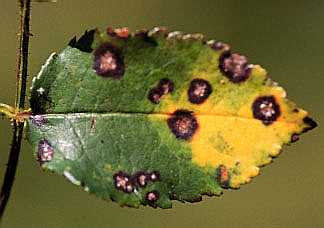
CAUSAL ORGANISM: Sphaceloma rosarum
Not much is known about this disease, however, it can be severe under cool moist spring conditions. Wild rose, climbers and ramblers seem most susceptible but hybrid tea and bush roses also get the disease.

SYMPTOMS: Initially leaf spots are about .5 cm diam and black, which makes them easily confused with blackspot. As the development progresses the spots become purple to brown and finally light brown or tan with a red or purple margin. Stems, hips and pedicles can also be infected and as lesions mature small black dots will appear in the papery tan centers. These black dots are the spore producing acervuli of the fungus. Spotting, yellowing and severe defoliation and shot hole can result under moist spring conditions.
DISEASE CYCLE: The fungus over winters in old lesions on leaves and canes. Warm spring conditions promote the development and release of spores from the acervuli in old lesions. The spores are believed to be carried by water or rain to newly expending leaves and stems. Not much is known about the sexual stage of the fungus or conditions favorable for spore germination. It seems that cool moist conditions are favorable for this disease as for Black Spot.
CONTROL: Removal of old leaves from around the base of plants and pruning out canes that have infections will do much to reduce the inoculum levels in spring. Generally, the same spray program that is used for Black Spot should work for Anthracnose also.
Horst, R. K. 1983. Compendium of Rose Diseases. The American Phytopathological Society, St. Paul, Minnesota. Pp. 20-21.
![]()
If you have any questions or constructive comments, I would love to hear from you, please send e-mail to Baldo Villegas
[ Home ]
[ Rose Pests Master List]
[ Rose Diseases ]
[ Insect, Mites, and other Animal Pests ]
[ Abiotic Rose Problems ]
[ Weed Pests ]
[ Hawaii Pests ]
[ The Good Guys ]
[ Help! Rose IPM ]
[ Horticulure Links ]
Copyright© 1995-2002 by Baldo Villegas
Last updated: January 21, 2002